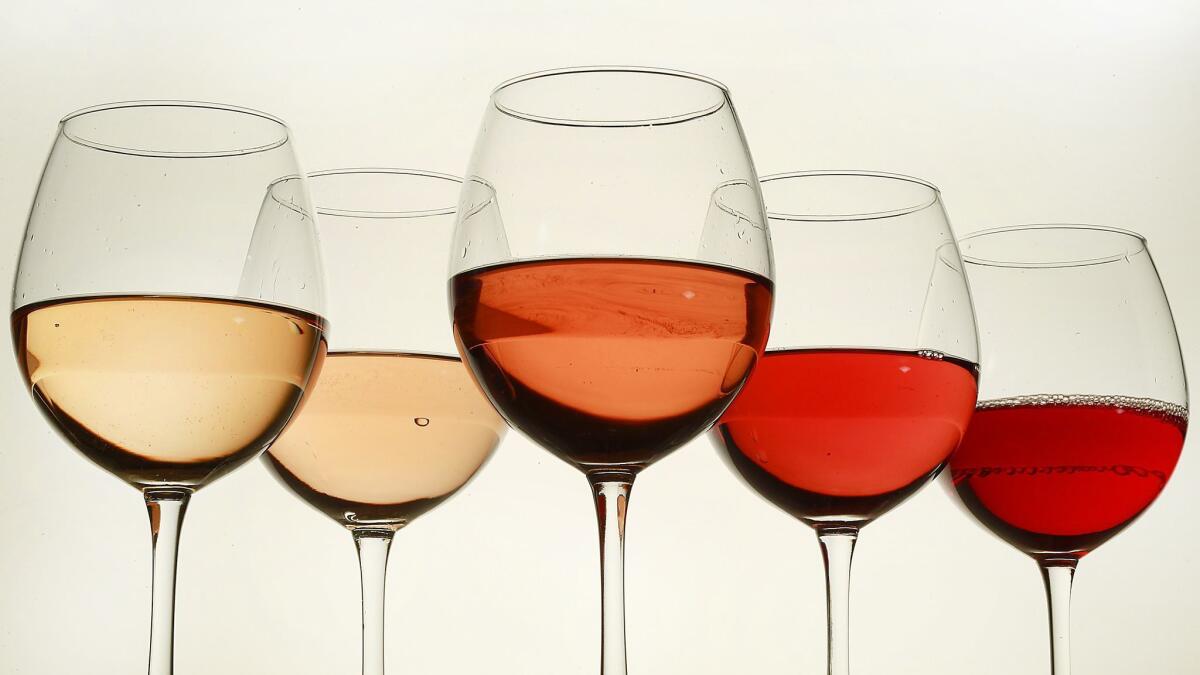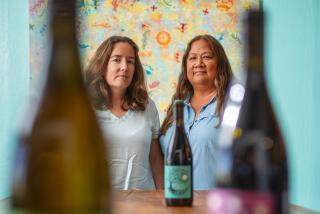Whatâs wrong with rosĂ© wines, and why you should never pay more than $25 for a bottle

Itâs spring, which means, in L.A. at least, that itâs officially rosĂ© season, that time of year when everyone, but everyone, is starting to think pink.
Did I say think pink? Sorry, I meant drink pink. When? Whenever, all the time, I mean, itâs rosĂ© oâclock somewhere, right? When youâve got on your rosĂ© colored glasses itâs rosĂ© all day. Iâm right, right? Because come on, weâre drinking rosĂ©!
As we enter pink wine season, we find ourselves in a category run amok. Demand is as riotous as a Black Friday toy sale at Walmart, and a towering tsunami of pink mediocrity has flooded the market to meet it. RosĂ© has not just jumped the shark, itâs jumped the whale next to the shark and the cruise ship bearing down on the whale.
Ten years ago wine writers, myself included, were begging people to try the dry, refreshing rosĂ©s of France, Spain and elsewhere, to stop painting all pink wine with the white Zinfandel brush. Sommeliers offered cheap glass pours and unabashed promotions, and even then couldnât give the stuff away. And now? They canât keep it in stock. A âfive-case dropâ (60 bottles) will barely get your average alfresco restaurant through the weekend.
Demand is such that practically every winery in California is obliged to make one, whether or not they have the grapes, the proper site or the aptitude. Does this matter? Not at all. Nobody cares what it tastes like. People just want something cold and pretty and Instagrammable in their glass.
RosĂ© is, in short, no longer a wine. Itâs a lifestyle ornament, a Cosmo made from grapes, a catchphrase, a punch line (rosĂ© oâclock, rosĂ© all day. brosĂ©), a poolside accessory, an excuse for all-day day-drinking, a thing to pound, to pose with, to signify on social media how much fun youâre having. It is the lubricant of the would-be leisure class. And that leaves every serious producer of pink wine practically drowning in a market they took pains to establish.
So let this column serve as a reset button for your rosĂ© habits. Feel free to pound the occasional can of plonk if you have to â even a can of Bud tastes good in the right circumstances. All Iâm asking is that you pay attention to three things: place, price and texture.
Place
The Pink Tsunami has set off unprecedented demand for rosĂ©s from traditional locales such as Provence, Rioja, Tavel, the CĂŽtes du RhĂŽne and so on. There are more pink wines from classic places than ever before, and generally the quality has suffered, despite marketing that seems almost desperate (unless youâre fond of âDigression,â the Provencal pink from âSecret Indulgenceâ winery. If thatâs your thing, have at it.)
But some lesser-known regions are taking advantage of demand, in places with almost no rosĂ© tradition at all â and some of them are astonishingly good. You owe it to yourself to check out the nervy Agiorgitikos from Greece, Blauburgunders from Germany, BlaufrĂ€nkisches from Austria and Cab Francs from the Loire. Theyâll surprise you.
Price
Rosé is usually cheap to make, spends almost no time in the cellar, and is released early: the cost of production is among the lowest of all categories of wine. Owing to demand, to pedigree, to consistency and excellence in winemaking, some wines are absolutely worth springing for, like some Bandol, some older Riojas, some Txakoli Rosés, the occasional California coastal pink.
But itâs worth remembering that a pink wineâs main function is simple refreshment, and that can be done on the cheap. So if youâre paying more than $25 a bottle, youâre almost certainly paying too much; more than $30, youâre being gouged, plain and simple, especially on overhyped lifestyle brands such as Domaines Ott, dâEsclans Rock Angel, and not least Miraval, the Brangelina RosĂ© from Cotes du Provence. Ask your retailer for wines that are every bit as good for less money.
Texture
Rosés by definition should be crisp, dry and quite literally mouthwatering. In the mouth they should be nervous, a little jittery from acidity, a little pithy from tannin (from the skin contact that gives the wine its color).
And yet most domestic bottlings are demonstrably sweet, with not only palpable residual sugar but a milky thickness of texture. One reason for this is that many rosĂ©s are made using the saignĂ©e method, juice bled off a fermenting tank to concentrate what remains, not so much a product as a byproduct. Often these are high in alcohol (more than 13.5%) rendering them too ripe and too fleshy to be refreshing. So if itâs sweet and thick, spit it out and move on.
Because above all, rosĂ© is a wine of intention. Itâs not an afterthought, not a byproduct, but something that had to be grown and made in the vineyard, harvested early to ensure good acidity and low alcohol, and made judiciously to preserve aroma and freshness. Settling for anything less is like selling your summer short.
Ten (somewhat) serious California rosés (all of them $25 and under, and 13% ABV and under).
Angeleno Wine Co., the Meadow, Lodi (Graciano, 12%) at Stanleyâs Wet Goods (stanleys.la), and Silver Lake Wine (silverlakewine.com), $22.
Arnot Roberts, Luchsinger Vineyard, Lake County (Touriga National, 11%) at DomaineLA (domainela.com), and K&L Wine (klwines.com), $25.
Bedrock, California, Ode to Lulu (Grenache & Mataro, a.k.a. Mourvedre, 12.3%) at Woodland Hills Wine Co. (whwc.com), and Wine Exchange (winex.com), $22.
Cep, Hopkins Ranch, Russian River Valley (Pinot Noir, 13%) at Wine House (winehouse.com), K&L Wines, and Lincoln Fine Wines (lincolnfinewines.com), $20
Habit, Demetria Vineyard Santa Ynez Valley (Grenache, 11.5%) at Wine House, Flask (flaskfinewines.com), and Wine Country (thewinecountry.com), $23.
Las Jaras, Mendocino County (Carignane, 13%) at Lou Wine Shop (louwineshop.com), and DomaineLA, $20.
Lioco, Mendocino County, Indica (Carignane, 11.9%) at K&L, Wine House, $20.
Liquid Farm, Santa Ynez Valley, Vogelsang Vineyard, (Pinot Noir, 11.5%), widely available, $20.
Skylark, Pink Belly, Mendocino County (Grenache, 12%) at Mission Wines (missionwines.com), Everson Royce (eversonroyce.com), $22.
Tercero, Santa Barbara County (Mourvedre, 12%) at Woodland Hills Wine Co., Mission Wine, and Everson Royce, $25.
More to Read
Eat your way across L.A.
Get our weekly Tasting Notes newsletter for reviews, news and more.
You may occasionally receive promotional content from the Los Angeles Times.









